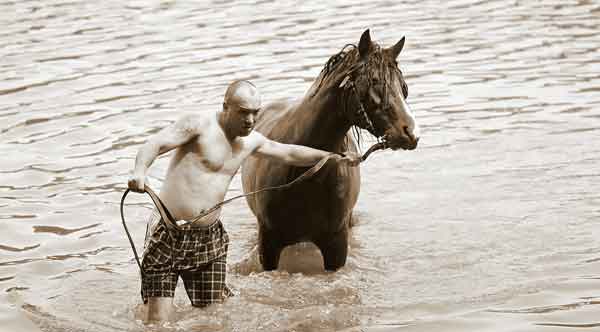Ever wondered if it’s a good idea to take your horse swimming in the water? Well, there are some things you need to know first.
Here’s everything you need to know about horses and water. All horses can learn to swim but there are a few tricks and safety issues you need to know.
Table of Contents
Can All Horses Swim?

Horses float pretty well and it seems like all of the different breeds know how to swim without being taught. It’s probably a combination of genetics and how the animal this built.
But this doesn’t mean that all horses are great swimmers nor that they like being in the water.
First and foremost, a horse can actually sink in the water if it cannot swim. So you need to start out with good experience in order to teach the animal to stay calm and focused.
Secondly, horses probably have it in their DNA to know how to swim. This is because horses at all times have had to cross rivers. It’s simply not possible to live your whole life (as a wild horse) without ever going into the water. The leader of the flock will at some point have you cross a river or a pond and then you just have to tag along.
Sometimes they just need to “unlock” the potential. Just like humans, they might need a few tries before they get it right.
How Do I Teach My Horse To Swim Better?
The first experience with water is very important for the horse.
This is where it gets its initial feeling of how dangerous (or not dangerous) the water is. It’s important to start out in shallow water and build up from there.
You should never throw the horse in deep waters just to force it to learn swimming. Nobody likes this and if this was your own first encounter with water you probably developed a phobia long before you learned to swim. Right?
So what’s the best way to start out?
You should start by visiting a little pond. Try to ride the horse all the way through without the water getting further up than 1 or 2 feet. From here you can work your way into the deeper water gradually.
The first time the animal is experiencing deeper water you should not be on its back. It can be both difficult and dangerous that’s what we will look at in a bit.
Now you need to find somewhere with no obstacles in the water. We don’t want the horse to step on anything pointy or to encounter any big stones under the water.
A good tip here is to take short rounds into the water and back on the beach. You can also write him a few steps into the water and let him stand for a while and then right back on the beach. By doing so you teach the animal that it’s possible to get back in safety.
Watch it carefully and make sure it doesn’t get too nervous. You should also make sure to ALWAYS stand at the front of the animal so you won’t get kicked by the feet as it pushes itself forward in the water.
A kick from a horse underwater is not as dangerous as a kick on the field but it’s still very powerful and it can easily knock you over or break your bones.
As your horse gets comfortable walking in the water it’s time to move on into deeper waters.
How Do Horses Swim?
A horse will swim in a way that is quite similar to what we see with larger dogs.
Because they are heavy creatures the majority of the body will be submerged in the water at all times. You will only see the head above water and it looks like they are paddling with the legs.
A horse will kick its way forward in the water.
When you watch it from underwater it almost looks like the horse is running. Here’s a little video clip that shows you the technique horses use underwater when they are swimming:
As you can see, it’s quite elegant. But that’s not the case in the first or second try.
The first few times the horse will be more awkward in the water and it will probably need you to guide it with the rope. You need to take a very proactive role during the first couple of times.
Can You Ride A Swimming Horse?
It’s very hard to ride a swimming horse for several reasons. It can also be pretty dangerous as we will look at it a bit.
The first reason why it’s hard to ride a swimming horse is that it is doing movements that are very different from riding. The horse is simply not as focused on you (as a rider) as it is on the ground.
On the ground, the horse knows exactly how to maneuver around in order to make it safe and easy for you to hold onto it. But in the water, it will be much more focused on moving forward because it’s not its natural environment.
As we mentioned before, it’s also quite dangerous to ride a swimming horse.
The first problem here is that you cannot always predict its movements. The horse will do some unexpected movements and it may also do some quick moves. This can cause the rider to fall off the horse and this is especially dangerous.
If you happen to fall off a swimming horse you might get kicked from the feet. That’s the most dangerous part of riding a swimming horse and why most people should stay away from doing so.
The last thing we need to mention here is the fact that only the head of the horse is above the water when it swims. This means that you will also largely be submerged in the water the whole time. This is definitely not an easy task and not something you should try for fun!
If you must…
If you do want to swim with the horse in the water there are a few things to be aware of.
- It’s really important that your weight is not pushing the horse down into the water.
Remember that the horse is a very heavy animal and it doesn’t swim well if it gets heavier than it already is.
You should swim as well in order to take the weight off the horse’s back and shoulder. By doing so you let the animals swim by themselves while you are sort of swimming on top of it. That’s much better than clamming onto the neck of the animal because that will probably freak out the horse and just cause you both to sink.
- Keep a safe distance to the kicking legs
You will normally have to swim beside the animal. If it catches up on you and swims faster than you, it is very important that you focus on where its feet are.
Trust me, you don’t want to be kicked in the water by a swimming horse!
If the horse starts to panic, you need to get away from it. You should not swim around it in order to keep it calm. It will struggle around and start kicking left and right just like you and me when we lose control in the water.
It would have to get back to the shore by itself. And so do you.
- Don’t’ swim too long as it might get tired before you do!
After 10 minutes in the water, a horse will probably be done. You don’t want to overdo it, especially not if you are unfamiliar with the animal in the water.
It’s tough for a horse to swim and it spends a lot more energy in the water than on the ground. At least you should take him to the beach after five or seven minutes in order to check with him that the breathing returns to normal pretty quickly.

Do Horses Like Being In Water?
At various tourist destinations, you can order a trip where you will be “swimming with horses”. This will normally mean that you will ride in shallow water where water covers up most of the horse.
This is a great experience if you are in a very warm climate and you like to cool off while taking a ride on the horse.
But what about the horse? Does it like to be in the water?
It totally depends on the horse. Just like with people.
Horses are generally good at swimming in the water so it seems fair to assume that most horses have a good time in the water. But there are certainly horses who don’t like to be in the water and not all horses are naturally good at swimming.
Why do horses paw at water?
At first, you might think that the horse is just having a fun time. But normally, this is never the case when the horses are pawing.
It’s probably doing so in order to test the waters. If it’s a horse with much swimming experience you probably don’t need to worry about it. But if your horses not used to swim, it’s important to pay close attention to what is going on.
You need to make sure the horse knows that you are in control of the situation. Force them to stop immediately and let him know that this behavior is not acceptable.
The reason why this can be dangerous is that you don’t want the horse to suddenly begin rolling over with you on top. It can be dangerous to sit on a horse that starts rolling over, especially in the water.
So make sure you stop it immediately.
Can Horses Hold Their Breath Under Water?
Horses cannot hold their breath underwater. So if there are big waves it can actually get pretty dangerous for the horse.
You definitely wouldn’t want to ride a horse in the water if it’s windy and the horse is in danger of getting the head under the water.
A horse can easily get stressed out if it gets its head under the water because is not able to hold its breath. It will simply drown if it gets the head under the water for too long. In that regard, we humans are much better swimmers.
If the horse gets the head underwater it can also suffer from getting water into the ears.
If that happens you need to guide the horse back into more shallow waters in order for it to reach the bottom. It will probably panic and it’s really important that you do not panic along with it. It needs to know that you are in control of this situation.
You have to grab the rope and keep it firmly in order to guide their horseback toward the beach.
The horse’s ears do not have drains as they do on humans. This means, that water running into the ears of the horse will be built up inside the animal and that can cause infections and other critical conditions.






